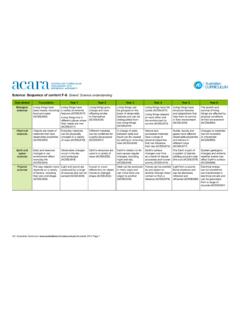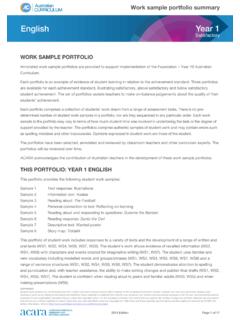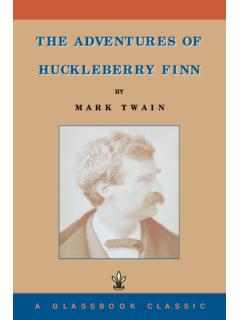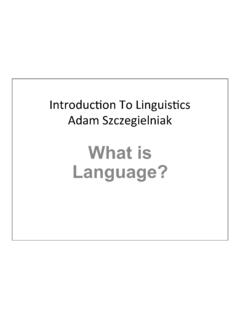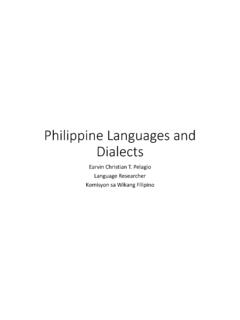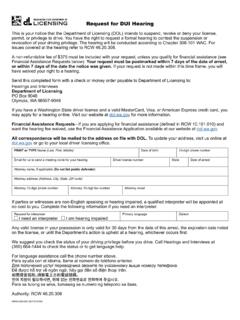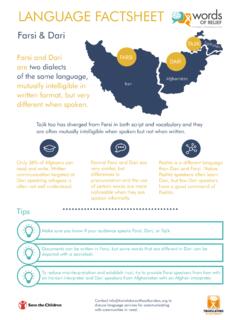Transcription of English as an Additional Language or Dialect: Teacher Resource
1 English as an Additional Language or Dialect: Teacher Resource EAL/D Learning Progression Version August 2011 This is an excerpt from ACARA s English as an Additional Language or Dialect: Teacher Resource . It contains the EAL/D Learning Progression. The complete Resource can be accessed from Australian Curriculum, Assessment and Reporting Authority 2011 This work is copyright. You may download, display, print and reproduce this material in unaltered form only (retaining this notice) for your personal, non-commercial use or use within your organisation. All other rights are reserved. Requests and inquiries concerning reproduction and rights should be addressed to: ACARA Copyright Administration ACARA Level 10, 255 Pitt Street Sydney NSW 2000 EAL/D LEARNING PROGRESSION English as an Additional Language or Dialect: Teacher Resource EAL/D Learning Progression 8 3. EAL/D Learning Progression Introduction This EAL/D learning progression describes a progression of English Language learning typical of students learning English as an Additional Language or dialect (EAL/D).
2 It has developed primarily for teachers who are not EAL/D specialists. EAL/D or English as a Second Language (ESL) documents developed by the states and territories (page 105) provide for more detailed and specialist information. Teachers can use this progression to: understand the broad phases of English Language learning that EAL/D students are likely to experience identify where their EAL/D students are located on the progression and the nature of their speaking, listening, reading/viewing and writing skills monitor the linguistic progression of their EAL/D students. By considering examples of EAL/D students work, including their speaking and listening skills, teachers can identify linguistic elements and/or behaviours that best match those found in the EAL/D learning progression. This will indicate the level of support that will need to be provided for students to access learning area content. Examples of considerations and strategies to assist teachers to adapt their curriculum delivery can be found in the advice for teachers of EAL/D students (page 83).
3 Student progress can be monitored at key points in the school program (such as reporting times) by referring to the EAL/D learning progression. The EAL/D learning progression includes: broad descriptions of the characteristics of learner groups at each of four phases of English Language learning. EAL/D students of any age may be in any of the Language learning phases: o Beginning English students with some print literacy in their first Language . A subcategory, Limited Literacy Background, is included to describe the reading/viewing and writing behaviours typical of students with little or no experience of literacy in any Language o Emerging English students who have a growing degree of print literacy and oral Language competency with English o Developing English students who are further developing their knowledge of print literacy and oral Language competency with English o Consolidating English students who have a sound knowledge of spoken and written English , including a growing competency with academic Language tables that describe an English Language learning pathway typical of EAL/D students for: o three stages of schooling (Foundation to Year 2, Years 3 to 6, Years 7 to 10) o the four phases of Language proficiency in each stage of schooling English as an Additional Language or Dialect.
4 Teacher Resource EAL/D Learning Progression 9 o the Language modes of listening, speaking, reading/viewing and writing in each of the four phases. The EAL/D learning progression is presented in two views. One view is organised by stage of schooling and phase of Language learning (page11). The second phase is organised by the Language modes of speaking, listening, reading/viewing and writing (page45). Both views contain the same information. Important considerations when using the EAL/D learning progression The EAL/D learning progression provides teachers with a brief summary of an English Language learning progression that EAL/D students typically make. It can take many years for an EAL/D student to complete this progression. Each of the four phases describes a period of significant English Language learning development, and there will be differences between a student at the beginning of the phase and a student at the end of the phase. EAL/D students will move through the four phases at different rates: some students may move through more than one phase in a school year; while some may take more than one year to move from one phase to another.
5 Students may also be at different phases across the Language modes of listening, speaking, reading/viewing and writing. For example, a student may be showing characteristics of Developing English in speaking, while still at Emerging English in writing. Students may appear to slip between phases at transition points, particularly between Developing English and Consolidating English or when they move from an Intensive English progression to a mainstream class, as they meet new academic challenges that require increasingly sophisticated use of academic Language . For example, a student may appear to be in the Consolidating English phase in Year 6, but new Language demands encountered in high school may mean that a student is better described in the Developing English phase in Year 7. Although the phases describe a developmental Language progression, the rate of progress and the extent of the achievement within each phase are dependent upon a number of factors including, for example, the nature of previous schooling, proficiency in the first Language and an individual s cognitive and emotional development.
6 The descriptions provide a broad account of Language learning behaviours typical of each phase they are not a comprehensive list and do not constitute a checklist. In broad terms, EAL/D students who demonstrate English Language proficiency at the Beginning English or Emerging English phases require informed EAL/D intervention in order to access content in the Australian Curriculum. In particular, students who have limited literacy in their first Language require informed EAL/D teaching to assist them to develop literacy in English . EAL/D students who are developing or consolidating their English as an Additional Language or Dialect: Teacher Resource EAL/D Learning Progression 10 English Language skills continue to require specific Language instruction in their mainstream classes. Additional advice for mainstream teachers of EAL/D students can be accessed through: the Advice for teachers (page 83) that provides important background information Additional EAL/D resources in the states and territories (page 105) the advice and support of specialist EAL/D teachers.
7 English as an Additional Language or Dialect: Teacher Resource EAL/D Learning Progression View by Stage of Schooling 11 EAL/D Learning Progression: View by stage of schooling Beginning English : Some print literacy in first Language The Beginning English phase of learning includes a sub category of Limited Literacy Background, to describe the development of reading/viewing and writing behaviours typical of students with little or no experience of literacy in Language . CHARACTERISTICS OF THIS LEARNER GROUP Each phase describes a period of significant English Language learning development. There will be differences between a student at the beginning of the phase and a student at the end of the phase. AGE-RELATED CONSIDERATIONS These students are starting to learn English . They can speak one or more languages/dialects other than English and have an age-appropriate level of print literacy in their first Language . They have had varying experiences of formal schooling and may be literate in their first Language .
8 In a familiar learning environment, they will begin to engage with simple Language tasks of the curriculum, particularly with support from a speaker of their first Language , and targeted contextual support (eg visuals and gestures). Learning a Language requires intense concentration, and students are likely to tire when listening to and speaking English constantly. High levels of explicit teaching of specific EAL/D skills are required from both the specialist Teacher and the classroom Teacher . These students are capable of understanding the concepts of the curriculum for their year level. However, as they are new to learning in and about English , they will find it difficult to show achievement as described in the achievement standards for their year level, as these rely heavily on English Language proficiency to convey content knowledge and understandings. While many of these characteristics are applicable to all students beginning to learn English , older students will have more life experiences as well as more developed cognitive abilities and will understand print in their first Language .
9 They draw upon their first Language literacy knowledge as they learn English . English as an Additional Language or Dialect: Teacher Resource EAL/D Learning Progression View by Stage of Schooling 12 Foundation to Year 2 BEGINNING English : SOME PRINT LITERACY IN FIRST Language (Years F 2) Listening Speaking Reading/viewing Writing Student progress can be monitored during the school year using the EAL/D learning progression. It is important to note that: placement on this continuum should be based on a body of evidence and not just one work sample ability in one mode is not an indication of ability across all modes. Learners at the beginning of this phase are unfamiliar with the sounds of English . In this phase, they begin to take cues from speakers around them and participate in simple classroom routines. Learners at the beginning of this phase communicate for the most part nonverbally in familiar social and classroom situations. In this phase, they begin to use isolated words and well-known formulaic expressions.
10 Learners at the beginning of this phase are new to print in English and to reading routines in Australian classrooms. In this phase, they begin to read and understand texts, read common sight words and use beginning knowledge of English sounds and symbols to decode words and begin to interpret the literal information in visual texts with Teacher support. Learners at the beginning of this phase are new to written English , although they may have some experience in another Language . In this phase, they begin to copy writing from the school environment and use beginning knowledge of English sounds and symbols to write and understand the concept of a word, and that speech can be written down, read and reread. Students: may not exhibit typical listening behaviours (eg looking at the Teacher ) or indicate if they have understood may begin to mimic the responses of others to spoken instructions (eg lining up at the classroom door) understand clear, unambiguous contextual support of gestures, images and modelling when being Students: use gesture to communicate, or body Language such as tugging on a Teacher s arm rarely initiate communications or participate verbally in group activities begin to mimic words used by teachers and classmates, and pick up very routine and repetitive Language that is associated with their immediate needs (eg no, toilet) Students.





